 Thank you for visiting HOJO website. If you have any enquiry, please feel free to get in touch with us at
Thank you for visiting HOJO website. If you have any enquiry, please feel free to get in touch with us at
▼ Akira Hojo
▼ Archives of Hojo Newsletter
▼ HOJO FACEBOOK





HOME >Japanese Tea Pot > Mumyoi
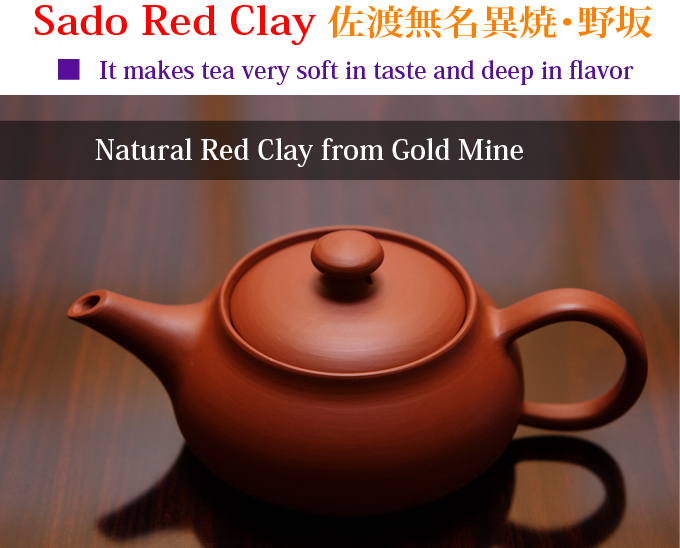
Mumyoi Yaki is a traditional craft of Sado Island (佐渡島) in Niigata prefecture (新潟県). Once upon a time, Sado Island produced large quantity of gold. When we mention about Sado Island, most of Japanese think of the gold mine. The Sado gold mine produced not only gold, but silver as well, and most importantly, it has natural clay with very high percentage of minerals granule. Long time ago, the red clay collected from the gold mine was used as a medicinal concoction. It was applied to the wound to stop bleeding.
In 1819, a man named Ito Kanbei (伊藤甚平) started to use the by-product of gold mine to make Raku Ware (楽焼). In 1857, the pottery in Sado Island was further developed by Ito Tomitaro (伊藤富太郎). At that time, red clay was partly used. It was mixed with other clays to get a specific character of Raku Ware.
The red clay produced in Sado Island is called Mumyoi Yaki (無名異焼). A revolution in Mumyoi Yaki was made by the first generation of Miura Jozan (三浦常山). He studied the art of Yi Xing tea pot, and developed his own baking method using mumyoi red clay. There was only a handful of artists who specializes in Mumyoi Yaki, nevertheless, they have managed to achieve acclaim and recognition by obtaining two National Living Treasure (人间国宝) awards; the first award in the history of Mumyoi Yaki was given to Miura Koheiji ( 三浦小平二), son of the 3rd generation of Miura Jozan, while the second award was given to Ito Sekisui (伊藤赤水).
Have you ever heard of "Sado Island" in Japan? This island belongs to Niigata Prefecture (新潟県) and it is located in the Japan Ocean. It is an island formed by the active underwater volcano and it has been in existence for many years.
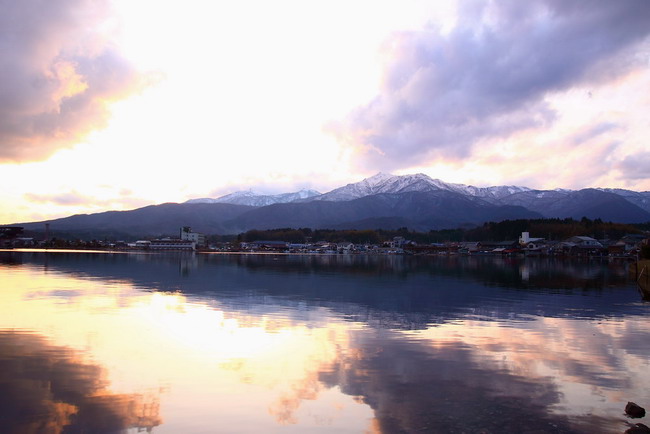
Sado Island is historically famous in Japan for only one reason: the gold. It is known as "The Island of Gold". During Edo Era, Sado Island had produced massive quantity of gold. The total length of mining tunnel leading to the gold mines to is estimated to be about 400km. The gold mine was discovered in 1601 and it was shut down in 1989. During this period, this gold mine had produced 78 tons of Gold and 2330 tons of Silver. It was the major source of revenue for the Tokugawa government.
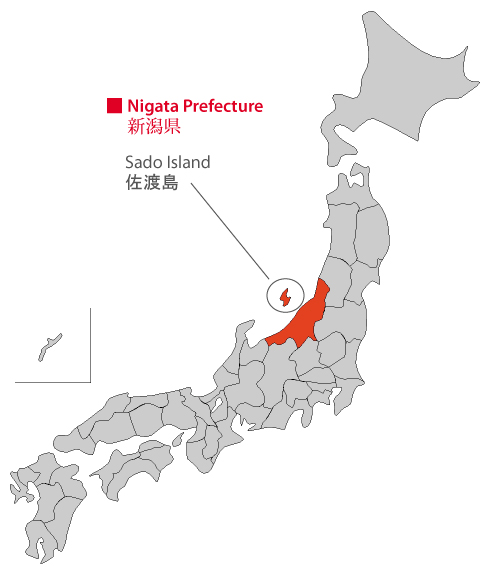
HOJO has two different series of teapot: Mumyoi teapot and Nosaka teapot. Mumyoi teapot is the traditional style. Artist uses a mixture of two types of clay, red and yellow. However we wanted to increase the purity of red clay to almost 100%. Together with the artist, we carried out series of experiment to find out the suitable type of red clay, percentage of respective clay, baking temperature and baking method. Lately, we managed to introduce Shimizu Ken's product that is made of new clays developed by our collaboration R&D.
We are also introducing another series called Nosaka. The property of Nosaka is similar to Yixing Zhuni in terms of the color of clay and its performance to the taste of tea.
These two new clays is very suitable for all types of tea, including ripe and raw puerh, Taiwan oolong, Japanese tea, Phoenix oolong and Wuyi oolong.
The affinity of clay with tea is as follow.
Watanabe Tozo Mumyoi :
Suitable for Taiwan oolong, Japanese Green, white, yellow, black and puerh
Not suitable for Tie Guan Yin, Phoenix oolong and Wuyi oolong
Watanabe Tozo Nosaka:
Suitable for all kinds of tea
Shimizu Ken Mumyoi:
Suitable for all kinds of tea
Shimizu Ken Mumyoi Reduction:
Suitable for all kinds of tea. In particular it works well for green tea, pipe puerh and heavily fired oolong
Shimizu Ken Nosaka
Suitable for all kinds of tea
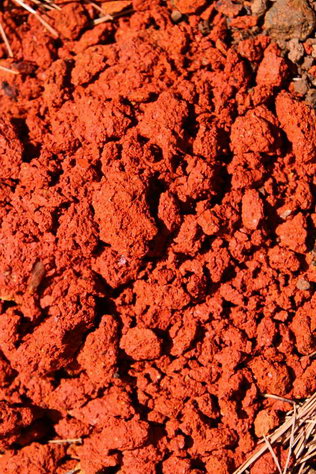 |
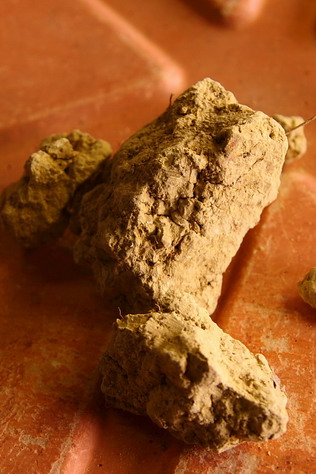 |
|
| Mumyoi: Red Color in natural condition. It contains veyr high iron more than 20% | Nosaka : Yellow Color in natural condition. But it turns red after baking. |
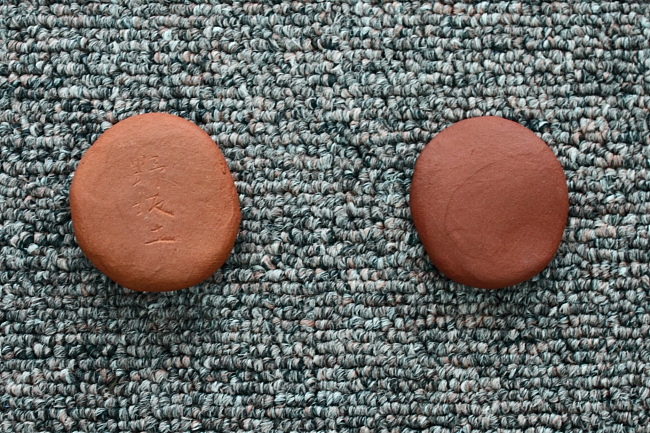
The photo shows Nosaka Clay and Mumyoi Clay after baking. Left: Nosaka and Right: Mumyoi
In fact, the term "red clay" is referring to the color of clay after baking. However crude clay material does not always appear in red color. It appears in between red to yellow. The intensity of color is depending on the percentage of iron. The more iron it contains, the more reddish color it becomes.The photo below is showing the typical crude clay that consist of yellow and red clay. Although both clay becomes red color after baking, the property seems different.
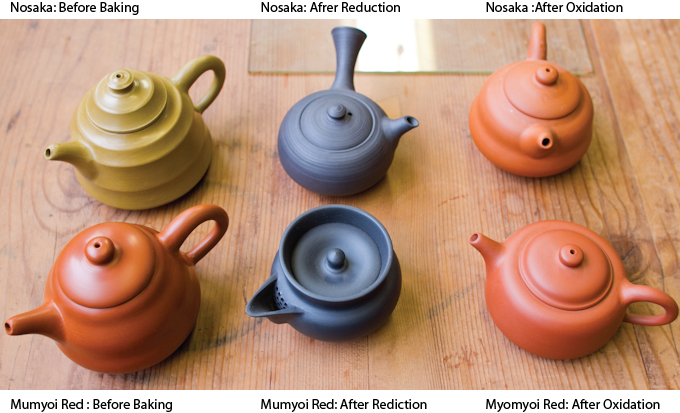
 Shimkizu Ken with Mumyoi red (left) and Nosaka yellow (right)
Shimkizu Ken with Mumyoi red (left) and Nosaka yellow (right)
For Reduction Baking, teapot has to undergo two steps of baking process. At first, teapot is baked with oxidation fire. Secondly, teapot is covered with rice husk or other materials and baked slowly at lower temperature. Due to lack of oxygen, the clay is reduced and the surface of teapots turns into black in color. In general, Reduction clay gives deeper after taste than oxidation clay. It is perfectly suitable for Japanese and Chinese green tea, ripe puerh and deep fired or aged oolong. With reduction clay, the flavor of tea becomes more delicate compared to oxidation clay. Thus, for Phoenix Oolong or Raw Pu-erh, an oxidation clay teapot is more suitable.
 |
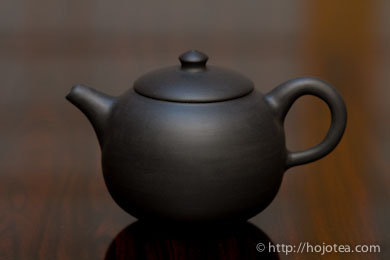 |
|
 |
 |
When I tried the traditional Sado red clay teapot for the first time, I was very impressed. Its performance was almost the best amongst Japanese clays. I have conducted tasting side by side with various kinds of Yixing Zhuni teapot as well. Sadly the performance of Yixing clay was outstanding and it was far beyond the performance of Sado red clay. However I felt there would be a better clay, other baking method or techniques that could improve the performance of Japanese teapot. After series of my research work with the artist, I have improved the performance of clay progressively. Finally, I managed to produce the teapot which performs much better than any Yixing teapot that I owned. I have various kinds of zhuni teapot made by Yixing artist and some were made before cultural revolution. With our latest lineup of Sado red clay teapot, Nosala in particular makes the taste of tea extremely smooth and the texture becomes creamy.
Once you visit any Chinese, Taiwanese or Japanese tea shop, you would see many tea pots in red color. Generally we call it "red clay teapot". Most of the red-color teapots available in the market, perhaps more than 99% are made of artificially blended red clay. To obtain the red color of artificial red clay, iron powder is added. Those artificially made red clays are not harmful to our health and its color is very similar to the color of natural red clay. However, it doesn't perform in the same way. In fact, its performance is nothing compared to that of Natural Red Clay teapot.
It is hard for us to tell the difference between artificial red clay and natural red clay just based on its outlook. Both artificial red clay and natural red clay contains a similar level of iron. In natural red clay, the minerals exist in granule-crystal form and it has higher melting point. Ground iron particle that is added in artificial red clay has much lower melting point. Usually the melting point of artificially added iron oxide is at around 600-700 degree C, while the melting point of natural iron crystal is at around 1200-1300 degree C. Usually clay teapot is baked at 1000 degree C or even higher temperature; artificially added iron granule will be melted during baking.
Because of the above reason, the natural clay has much higher porosity. Naturally the number of mineral ion being released from the clay is greater and it has more influence on the water quality.
Mumyoi natural red clay
Refining process of Sado red clay by Shimizu Ken
In China, the natural red clay was used as a medicine to stop bleeding. In 1596, when a Chinese medical doctor (李時珍) re-organized the Chinese medicine book (本草網目), he realized that no suitable name was given to this "red clay". He had tried to think hard for its name, yet he could not get a suitable name. Finally, he named it as Mumyoi (無名異), which means "Unknown".
Go to the Mumyoi Page Appears in 本草網目 in Chinese >>
During Edo era, Japan was also importing the "Mumyoi Medicine" from China. As they found Sado red clay posses the same properties, it was also named as Mumyoi. The clay ware made from this clay was called Mumyoi Yaki (無名異焼).
Besides Sado Island, there are a few more historically famous gold & silver mines in Japan.
There is an interesting fact. According to the record, Izu Gold Mine (in Shizuoka Prefecture, Izu Peninsula) and Iwami Silver mine also produced red clay called "Mumyoi". In particular, Iwami was also producing red clay ware. Unfortunately, Iwami has stopped making red clay ware since their red clay was no longer available.
Go to the Page of Iwami Silver Mine >>
People often talk about "clay made of volcano". In fact, it is nothing special if you understand the relationship between volcanoes and forming of minerals.
Do you know where those minerals come from?
They are produced by the volcano. Gold mine is formed because of volcano. When lava erupts from the ground, it carries a mixture of minerals dissolved in hot water. When it cooling down slowly, minerals re-crystallized and formed the Quartz in between the gap of rocks.
Besides the Sado Island that is made of underwater volcanoes, Japan also has a number of volcanoes scattering over the country. As a matter of fact, Japan is a very ideal island to produce the fine clay for making tea pot. In addition, there is also a big chance to discover more gold somewhere deep under the mountains.
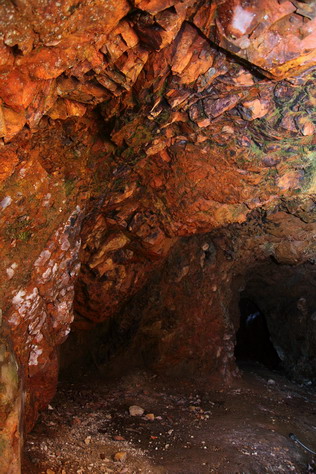 |
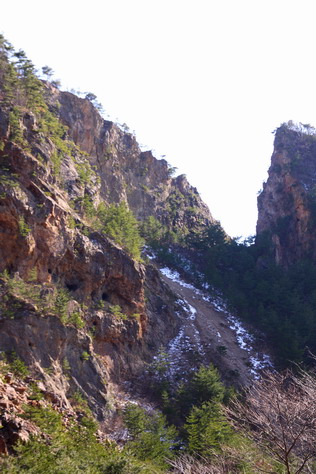 |
|
| Crude rock of red clay appears at the internal wall of gold mine | Mountain has a number of hole and tunnel that are made in the seek of gold. The surface of mountain shines in purple color as those rocks contains high percentage of iron. |
It is said that Mumyoi teapot becomes very shiny after using it for some time. When it is well-seasoned, you can actually see your reflection on its surface. After being heated, the red clay shrinks to more than 30%; the gaps between the clay structure is compacted and are very close together. It easily traps substances from tea and thus forming a very shiny surface.
Many customers describe that the texture of Mumyoi teapot is as smooth as silk. There is another important process which contributes to this fine texture of Mumyoi teapot. The process is called "Namamigaki". It is carried out after teapot is partially dried at room temperature. The surface of the teapot is pressed by rods or stone to smoothen and harden its surface. This process is the most time-consuming work but it makes the surface of the clay very solid and tight. Even the "Namamigaki" expert can only complete 5 teapots in a day. Each teapot requires at least two times of "Namamigaki" process.
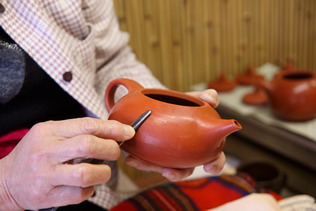 |
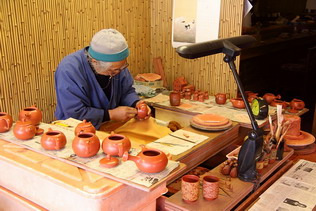 |
|
| Half-dried clay is pressed with a metal rod. Sometimes, stone is also used. | Namamigaki seems to be the traditional process in Yi Xing as well as Banko. |
Most tea pot artists have exceptional skills in producing high quality tea pots and they are rapidly becoming a rarity. In Sado Island, two artists were awarded the Living National Treasure of Japan and it is such a great honour.
However the number of Sado red clay artists is decreasing and they are aging. No doubt that they are in great demand. Obviously there is very less successor as well. It is very difficult to find artist who makes pure red clay teapot with back handle style. Sadly many of them use Sado red clay as the base clay to produce glazed teapot or celadon ware.
Right now Sado Island is applying for the World Heritage status. Once it is registered, the supply of Sado red clay may be even more critical.

In English, Zisha means purple sand. Any types of clay produced in Yixing is called Zisha. So if a person mentions about Zisha teapot, it doesn't really mean anything specific about the type of clay.
In general, Zisha consists of many types of clays, red clay, purple clay and green clay. With higher percentage of iron (above 20%) and less amount of other metals, it is called red clay, such as Hong-ni or Zhu-ni. Usually purple clay contains less than 10% of iron and it also contains various kinds of other minerals, such as copper, zinc and tin. In green clay, the dominat mineral is either
copper or chromium. In Sado, you can find rocks in purple or green color everywhere, and people out there is getting used to it. If I have a chance, I wish to produce teapot using those clays.
Yi Xing Zisha generally consists of 3 different clays, red clay, purple clay and green clay. With higher percentage of iron (more than 20%) and less amount of other metal, it is called red clay. Purple clay contains usually less than 10% of iron and it also contains various other minerals such as copper, zinc and tin. The dominant mineral in green clay is either copper or chromium, Green clay is only meant for decoration as it makes take of tea very flat.
In fact the most of rocks in Sado mountain is made of very similar clay. In Sado,you will see the rocks in purple color everywhere and people out there is getting used to it. Just like Yi Xing, Sado island has red clay, purple clay and of course green clay as well. People used to call Sado island as theIsland of Gold. For now, it is the "Island of Clay".
 |
 |
|
| Crude red clay: This rock is as heavy as iron bar. | Mixture of red and purple color. It contains large amount of iron. |
 |
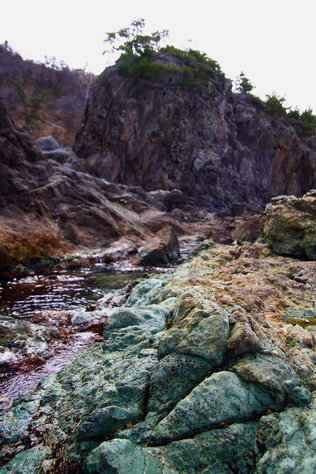 |
|
| Crude green clay found in Sado island | The Sado gold mine is located near the beach. We can find various kinds of crude clay rock at the beach. The photo shows the huge green clay rock. |
Watanabe Tozo (渡辺陶三) was born in 1939. He is coming to 73 years old. His father was Watabane Kokuzo(渡辺国三), also famous in making Mumyoi Red Clay teapots. In 1981, his teapot set was presented to the emperor of Japan. Besides, the prince of Japan has visited his workshop and stayed there for a day to learn pottery from him.
Watanabe Tozo also has paid much attention to Yi Xing teapots. Unlike to ordinary teapot artists in Japan, he often traveled to Yi Xing, Korea and Taiwan. His teapot was influenced by those Chinese teapots design, yet he has his own style.
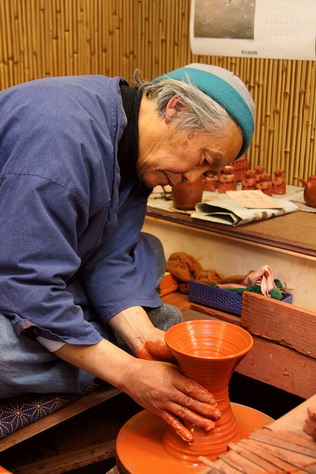 |
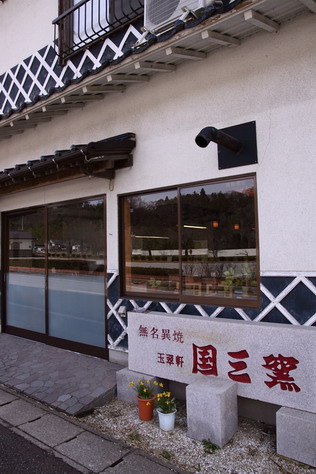 |
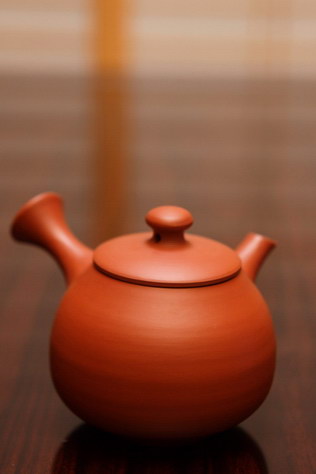 |
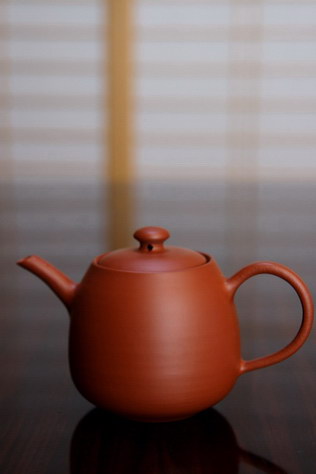 |
|
Mumyoi 01 |
Mumyoi 02 |
|
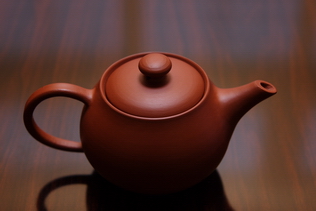 |
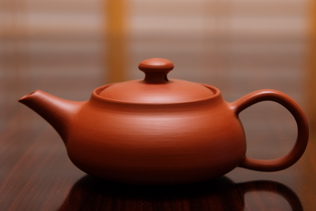
|
|
Mumyoi 07 |
Mumyoi 08 |

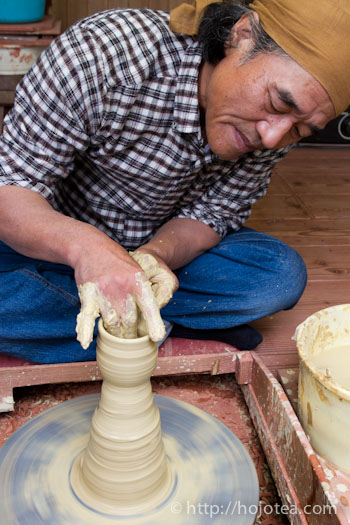
|
Shimizu Ken is now at 62 year's old. He has started pottery when he was teenage learning after his father. He was born in the artist family. His grand father was well known for copper cast and his brother is now in France specialized in modern painting.
HOJO works very closely side by side with him for the development of new clay. Most of good clay HOJO introduced from Sado was developped thanks to him who was always willing create his product using new clay.
The photo on the left shows Shimizu Ken who is making teapot using Nosaka. |

 |
We accept various kinds of credit card through Paypal.
Only if customer prefer other option of payment, we suggest "Bank Transfer".
Various choice of shipping method
EMS, SAL, Small Packet, Small Packet (SAL) Yamato Express and Surface
For shipping tea, we usually suggest small air parcel, the estimated shipping cost of tea in 100g (with wrapping material ) is
Small Parcel
USA JPY 600, EU JPY600 and Asia JPY470
Small Packet (SAL)
USA JPY380, EU JPY380 and Asia JPY320
The shipping fee to oversea by small air parcel happens to be even cheaper than domestic shipping fee in Japan.
For your information, some countries, EU in particular imposes custom duty. We need buyer to bare the duty. We are sorry, but we cannot change the amount on the invoice, and we do not mark any packages as gifts. We will strictly follow the custom regulation.